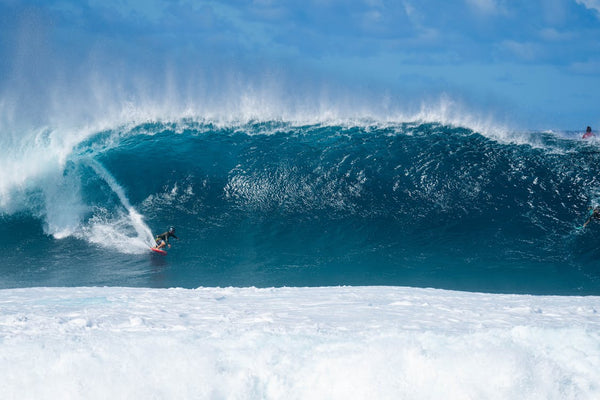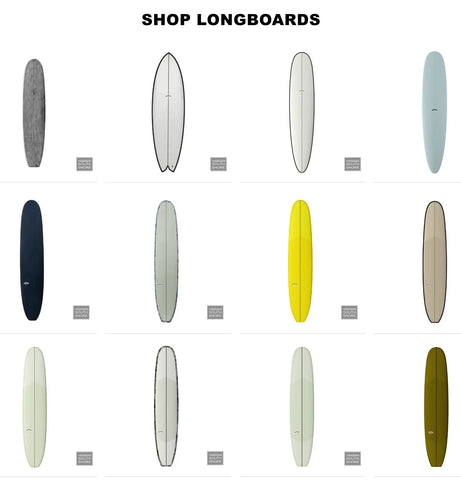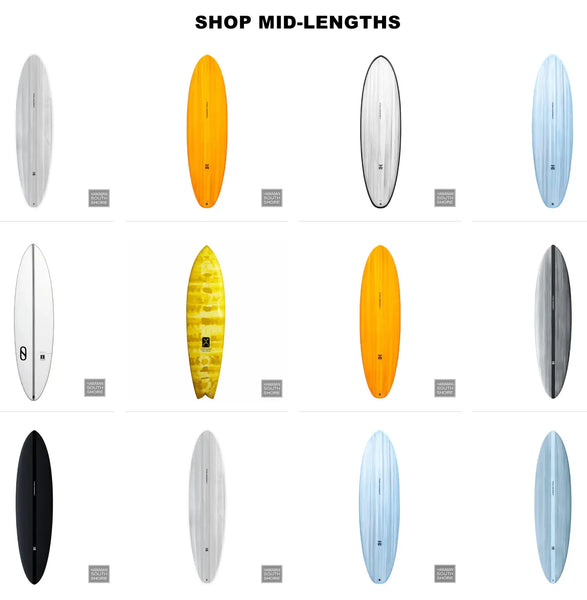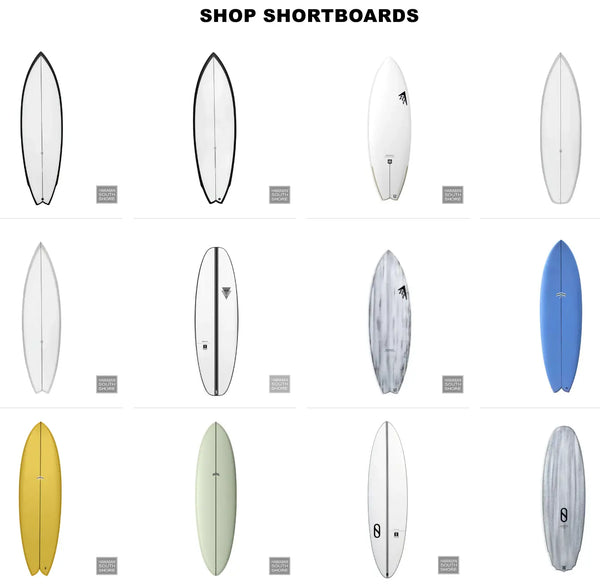Apr 25, 2024
How to Surf Better Part 6 of 9: Choosing the Right Board
Buying your first surfboard—or any new board, for that matter—is an exciting experience. But it can also be a very confusing one, since there are so many different options out there. Not only are there dozens of different worldwide surf brands (and thousands of local shapers around the world), but there are also a number of different types of boards, ranging from longboards and funboards to shortboards, hybrids, retros, and specialty boards such as big wave guns and logs.
To help you figure out what board is best for you, we’ve put together the definitive guide to types of surfboards, and choosing the perfect one for you.
Longboards
Best for: Tiny waves, beginners, plus-sized surfers, and anyone who just wants to cruise.
What we call longboards today used to just be called surfboards—at least until the Shortboard Revolution in the 1960s. Aside from the alaias ridden by early Hawaiian wave-riders, virtually every surfboard made before 1960 was a longboard. After the shortboard took over in the 1970s, longboards virtually disappeared from the scene until the late 1990s, when forward-thinking throwbacks like Joel Tudor reminded us how much fun it is to glide on big boards with lots of volume.
Today, the term longboard covers a wide range of boards, from high-pro longboards to logs and other traditional noseriders. That being said, they all have a few things in common. For one, we tend to consider a board a “longboard” if it is over nine feet long. Longboards also tend to be pretty wide (20 to 23 inches), thick (around three inches), and typically don’t have much rocker (this means that they are relatively flat from nose to tail). These characteristics combine to create a board that is easy to paddle and relatively easy to balance on, due to its size and stability. The increased volume (often upwards of 90+ liters) and low rocker also help longboards trim through flat spots and weak waves well.
When selecting a longboard, it is important to first evaluate your ability and what you are hoping to get out of the board. If you are a beginner, you’ll probably want something that is big enough to paddle fast, but small enough to still be somewhat maneuverable. This will depend somewhat on your weight, but generally speaking something between 9’0” and 10’0” should do the trick. A 2+1 fin setup (a long center fin with smaller stabilizer side fins) and hard rails near the tail will also make the board more maneuverable.
For those looking to focus on noseriding, a log or traditional noserider is the better call. (Logs refer to any longboards that are designed to be somewhat of a throwback to pre-1960s boards. They tend to be heavier single fins with round, 50/50 rails, and often no leash plug.) Logs are super fun and can noseride like a dream, but they come with a major sacrifice—maneuverability. Because they are heavy and lacking in both rocker and edge in the rails, they do not turn well—so if you aren’t already an accomplished surfer, you are better off going with a modern longboard.
Funboards/Mid-Lengths
Best for: Beginners, throwbacks, and anyone looking for an alternative to the modern shortboard experience.
While diehard surfers will make a point of differentiating between funboards and mid-lengths, they both tend to be around the same size (anywhere from around 7’0” to 9’0”) and have some common attributes (such as increased volume and wider noses). Funboards are often thought of as beginner boards, and typically look like miniature modern longboards. They still have that extra paddle power from the increased volume and length, but are a lot easier to turn, since they are shorter than longboards and often have thruster or 2+1 fin setups.
Mid-lengths, on the other hand, typically refer to retro boards that are longer than shortboards but shorter than longboards. These tend to be a bit harder to surf, and are typically ridden by experienced surfers looking to tap into the feeling that early wave riders had back in the 1960s and 1970s. They are also popular with longboarders who are looking for something a bit more versatile when the wave get bigger, as well as style-focused shortboards who simply want to mix things up. Mid-length designs range from stretched out, oversized retro fish to Wayne Lynch-inspired Evolution single fins (and everything in between). They tend to feature retro outlines and fin setups (such as twins and single fins) and be built with a bit more attention to a retro aesthetic (such as gloss coats, cut laps, etc.). That being said, pretty much anything between 7’0” and 9’0” that isn’t a gun, mini-gun, or big-guy shortboard is technically a mid-length, so don’t let the hipsters make you feel bad if you call your funboard a mid.
Modern Shortboards
Intermediate to expert surfers who want to focus on progressive, high-performance wave riding.
Shortboards are, by definition, relatively short—although their actual length isn’t the main factor in categorizing them. After all, a little kid’s shortboard could be 5’0”, while a shortboard for a guy who is 250 pounds could be two feet longer. Instead, what really defines a shortboard is a pulled in nose, relatively low volume (compared to longboards and mid-lengths), modern bottom contours, rails, tails, and rockers, and thruster or quad fin setups. Although there is a wide range of designs within this category (flatter, more voluminous shortboards will go better in weak waves, whereas shortboards with more rocker and pulled in tails will do better in barrels), they are all relatively similar, in that they are built to go as fast as possible and perform radical maneuvers (i.e., sharp turns in critical sections).
The biggest mistake people make when buying shortboards is going too short and too low in volume—both because they see pros riding super short boards, and because shorter boards are easier to turn. But riding something that is easier to turn doesn’t necessarily make you learn to turn better—and most of us don’t have the fitness or abilities of pro surfers, which are needed to get the most out of short, anorexic high-performance shredsticks. Fortunately, modern shapers have begun to focus more on the everyman surfer rather than just pros, and there is a wide variety of shortboards available to surfers of virtually every ability and fitness level.
Retro Shortboards
Best for: Anyone looking for an alternative to modern boards, particularly one that emphasizes trim and fun.
Although most logs and many mid-lengths are considered retro boards, there are also retro shortboards—boards under 7’0” that typically have fuller templates, more volume, retro contours, and older fin setups, such as single fins, 2+1s, twins, keel twins, and Bonzers. Some of the more common retro shortboards include Steve Lis-inspired fish, short single fins, Bonzers, 1980s-style twins, and mini-Simmons.
These retro shorts tend to emphasize trim, glide, and down-the-line speed, although they are still quite a bit more maneuverable then mid-lengths and longer boards. They are a ton of fun, especially when the waves aren’t very powerful, but they do require a more advanced skillset, since they are lacking many of the modern design elements that make high-performance boards so easy to ride. Ultimately, they are another way for intermediate+ surfers to broaden their experience and enjoy different feelings from different eras.
Hybrids
Best for: Intermediate+ surfers looking to add a bit of speed to their high-performance boards.
Hybrids are exactly what they sound like—a hybrid between modern shortboards and the faster but less maneuverable fish of the 1970s. These boards tend to be a bit flatter, wider, and shorter than high-performance shortboards, and are often ridden as twins or quads (although they can also be ridden as thrusters). They provide more down-the-line speed, rather than requiring the surfer to generate all of the velocity, which makes them great for smaller, weaker waves that lack push, but where you still want to rip and ride a shortboard. Of course, the compromise here is that they lose a bit of their high-end maneuverability, so don’t expect them to perform quite as well as modern shortboards, at least in terms of progressive maneuvers.
Finless Boards
Best for: Advanced and expert surfers who are bored with normal surfing.
People have been riding finless boards for as long as surfing has been around. In fact, the early alaias and olos of the original Hawaiian surfers all lacked fins, as did the first mass-produced longboards. Fins didn’t actually come into use until Tom Blake put the first “skeg” on a board in the 1920s. From that point on, finless boards pretty much disappeared—although there were still a few obscure throwbacks riding them, as well as the occasional standup bodyboarder, such as Waianae’s Danny Kim. That all changed in the early 2000s, when Tom Wegener kickstarted the alaia renaissance. From there, a variety of different finless boards began to pop back up in surfing culture, from the super-channeled fiberglass designs of Derek Hynd to finless softtops like the CatchSurf Beater. Generally speaking, these boards are all very difficult to surf, and are only ridden by a small niche group of novelty wave riders. That being said, if you can figure out how to make them go, they are a super fun, super unique way to approach waves.
Big Wave Guns
Best for: Anyone who wants to charge.
Big wave guns tend to refer to boards that are longer than 8’6” and designed to surf XL waves (25 feet on the face and bigger), but for the sake of simplicity, we will also include step-ups and mini-guns in this category, since they all have similar design elements. Step-ups are typically ridden a few inches bigger than your normal shortboard, and are built for hollow, powerful waves in the overhead- to double overhead range. They tend to have a bit more rocker and pulled in tails (often round tails or thumbnails, although some have rounded pins), which make them perform better in hollower waves and at high speeds.

Miniguns are essentially longer step-ups made for even bigger, hollower waves, such as double to triple overhead Pipeline or Sunset. These boards typically range from around 6’6” to 8’6” and have even more exaggerated design elements for powerful waves (including more rocker and drawn in round pin or pintails). Finally, proper big wave guns start at 8’6” and go up to as long as 11’0”. They are built for waves bigger than 10 foot (Hawaiian), and tend to feature sharp pin tails, long, straight rails, and extra volume (sometimes hidden in the chest, and sometimes more obvious). While step-ups and mini-guns are still pretty narrow and think (18 to 19 inches wide and less than 3 inches thick), proper guns can be as wide as 22 inches and more than 4 inches thick. Their main goal is to help the surfer paddle into huge waves that are moving much faster than normal, while performance is a secondary consideration (although still an important one, as big wave surfers strive to make their waves to the shoulder, and in more extreme cases ride huge barrels). If you are shopping for step-ups, mini-guns, or guns, you probably already know quite a lot about surfing and how different surfboards work.
Softtops
Best for: Beginners, or anyone who is bored with normal surfboards and looking for something silly to do.
Softtops are exactly what they sound like—soft, foam boards with hard plastic bottoms (similar to bodyboards, except shaped like normal surfboards). Although early softtops were pretty basic and subject to a lot of hating from surfing purists (think Wavestorms from Costco), they have now become hugely popular with just about everyone, and are a great way for total beginners to get a feel for surfing without spending a lot of money on a new board, ding repairs, or lawsuits from hitting people with their fiberglass boards. They are also lots of fun if the waves are crap and you are just going out for a grovel with the keiki, or if you are pulling into shorebreak closeouts and don’t want to break a bunch of expensive boards.
Softtops are also used for SUP's, it's worth noting that many water sports enthusiasts enjoy multiple activities not just surfing. If you're interested in exploring the underwater world as well as riding waves, you might want to check out a diving gear online shop to complement your surfing equipment.
Recently, a number of high-quality, high-performance softtops have hit the market, bridging the gap between popout softtops and normal surfboards. The boards from Crime, in particular, are an interesting concept, as they combine normal fiberglass boards with a soft foam deck, making them safer than normal surfboards, but without completely sacrificing maneuverability.
As you can see, there are almost as many options for types of surfboards available as there are waves to ride. Whether you are a brand new surfer or an expert looking to increase the size of your quiver and the range of your abilities, there are lots of ways to have fun in waves—and the different feelings you get from different boards can completely change your experience in the water.
No matter what style you decide to go with, getting a new surfboard is a lifechanging experience. Even pros who have gotten hundreds of new boards throughout their careers still feel that little bit of magic every time they pick up a new stick, slap on a deck pad, and apply that first coat of wax. It’s the magic of possibility, the anticipation of the waves that they will ride, and a sense of wonder at where the board might take us that hits us in the pit of the stomach and gives us that butterfly feeling of excitement. That feeling is the reason I opened Hawaiian South Shore more than 20 years ago, and I hope that we are able to help you discover (or rediscover) it this year!
More Articles👈
Waves of the North Shore Series



